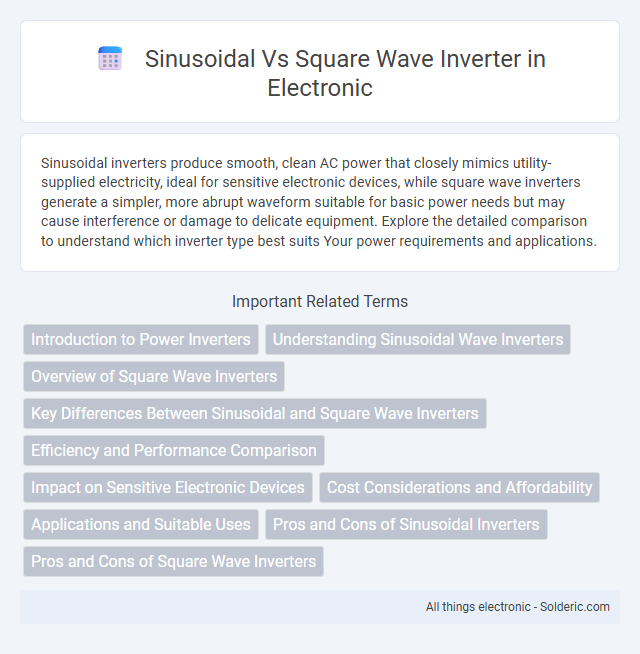Sinusoidal inverters produce smooth, clean AC power that closely mimics utility-supplied electricity, ideal for sensitive electronic devices, while square wave inverters generate a simpler, more abrupt waveform suitable for basic power needs but may cause interference or damage to delicate equipment. Explore the detailed comparison to understand which inverter type best suits Your power requirements and applications.
Comparison Table
| Feature | Sinusoidal Wave Inverter | Square Wave Inverter |
|---|---|---|
| Output Waveform | Pure sine wave, smooth and continuous | Square wave, abrupt transitions |
| Power Quality | High-quality power, low distortion | Lower quality, high harmonic distortion |
| Compatibility | Compatible with all AC devices | Limited compatibility, not suitable for sensitive electronics |
| Efficiency | Moderate efficiency | Higher efficiency due to simple design |
| Cost | Higher initial cost | Low cost, economical choice |
| Noise | Minimal electrical noise | More electrical noise and interference |
| Applications | Sensitive electronics, home appliances, medical devices | Simple tools, basic lighting, motor loads |
Introduction to Power Inverters
Power inverters convert DC power from sources like batteries or solar panels into AC power suitable for household appliances. Sinusoidal inverters produce smooth, continuous waveforms that mimic utility power, ensuring compatibility with sensitive electronics, while square wave inverters generate simpler, abrupt waveforms best suited for less complex devices. Your choice between sinusoidal and square wave inverters impacts the efficiency, noise levels, and device safety in your power system.
Understanding Sinusoidal Wave Inverters
Sinusoidal wave inverters produce a smooth, continuous waveform that closely mimics the natural AC power supplied by utility grids, ensuring compatibility and efficient operation of sensitive electronic devices. These inverters reduce harmonic distortion and electrical noise, protecting your appliances and improving their lifespan. Understanding sinusoidal wave inverters is essential for applications requiring clean power, such as audio equipment, medical devices, and advanced home electronics.
Overview of Square Wave Inverters
Square wave inverters produce a waveform that abruptly switches between high and low voltage levels, resembling a rectangular shape. These inverters are typically simpler, more affordable, and easier to design, but their output contains significant harmonic distortion, which can cause inefficiencies and overheating in sensitive electronic devices. Square wave inverters are suitable for basic applications where waveform purity is less critical, such as simple resistive loads and certain types of motor drives.
Key Differences Between Sinusoidal and Square Wave Inverters
Sinusoidal inverters produce smooth, pure sine wave output closely matching utility power, making them ideal for sensitive electronics and appliances, while square wave inverters generate a more abrupt, block-shaped waveform that may cause noise or damage in delicate devices. The efficiency and compatibility of sinusoidal inverters typically exceed those of square wave inverters, offering better performance for motors and audio equipment. Choosing the right inverter depends on your device requirements and the need for clean, stable power delivery.
Efficiency and Performance Comparison
Sinusoidal wave inverters deliver higher efficiency and superior performance in sensitive electronic devices due to their smooth, pure waveform that reduces harmonic distortion and electromagnetic interference. Square wave inverters, while simpler and cheaper, exhibit lower efficiency because their abrupt waveform causes increased heat generation and potential damage to inductive loads and motors. The clean sinusoidal output ensures better energy conversion and longer device lifespan compared to the noisier, less efficient square wave alternative.
Impact on Sensitive Electronic Devices
Pure sinusoidal wave inverters provide a smooth and stable AC output that closely mimics the utility grid, ensuring compatibility and protection for sensitive electronic devices such as medical equipment, audio systems, and computers. Square wave inverters produce a choppy, non-sinusoidal waveform that can cause overheating, malfunction, or reduced lifespan in devices with inductive loads or sophisticated microprocessors. Choosing a pure sine wave inverter minimizes electromagnetic interference and prevents potential damage, optimizing performance and reliability for sensitive electronics.
Cost Considerations and Affordability
Sinusoidal wave inverters generally come at a higher cost due to their complex design and ability to produce clean, consistent power ideal for sensitive electronics. Square wave inverters are more affordable and simpler, making them suitable for basic applications where cost is a primary concern. Your choice depends on budget constraints and the specific power quality requirements of your devices.
Applications and Suitable Uses
Pure sine wave inverters are ideal for sensitive electronics, medical equipment, and audio systems requiring clean, stable power. Square wave inverters suit simple tools, basic lighting, and devices with universal motors that tolerate less precise waveforms. Selecting the inverter type depends on device sensitivity, power quality needs, and cost considerations.
Pros and Cons of Sinusoidal Inverters
Sinusoidal inverters produce a clean, smooth waveform closely matching the utility grid, making them ideal for sensitive electronics and providing higher efficiency with less harmonic distortion. They are more expensive and complex compared to square wave inverters, which can cause noise and potential damage to delicate appliances. Their superior power quality enhances motor performance and reduces heat generation in devices, justifying the higher initial investment for critical applications.
Pros and Cons of Square Wave Inverters
Square wave inverters are cost-effective and simpler in design, making them suitable for basic applications that do not require a pure and stable power output. Their main drawbacks include producing higher harmonic distortion and generating more electrical noise, which can damage sensitive electronic devices and reduce efficiency. Square wave inverters are generally less compatible with modern appliances and motors compared to sine wave inverters, limiting their use in advanced or critical systems.
Sinusoidal vs Square wave inverter Infographic

 solderic.com
solderic.com